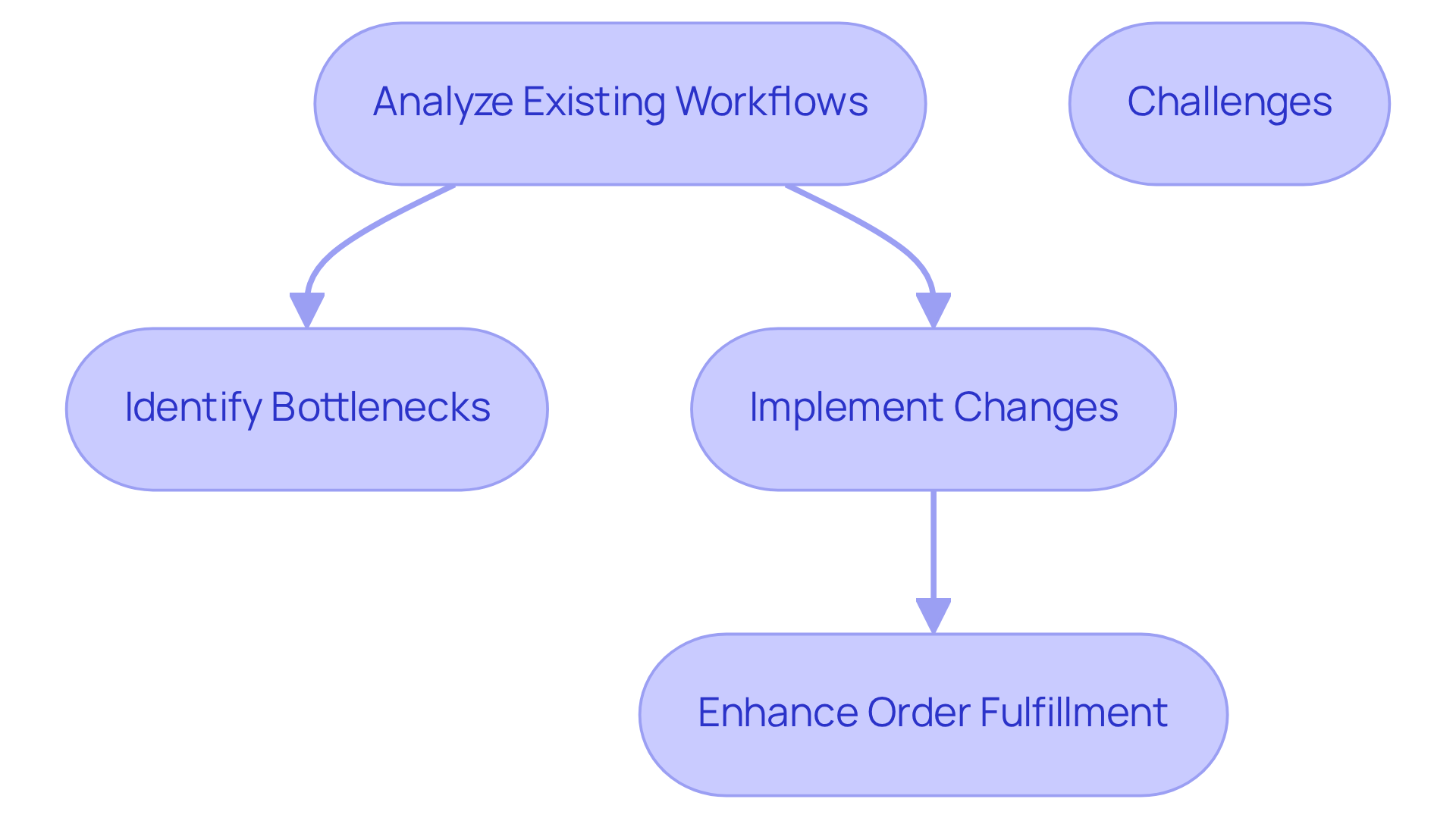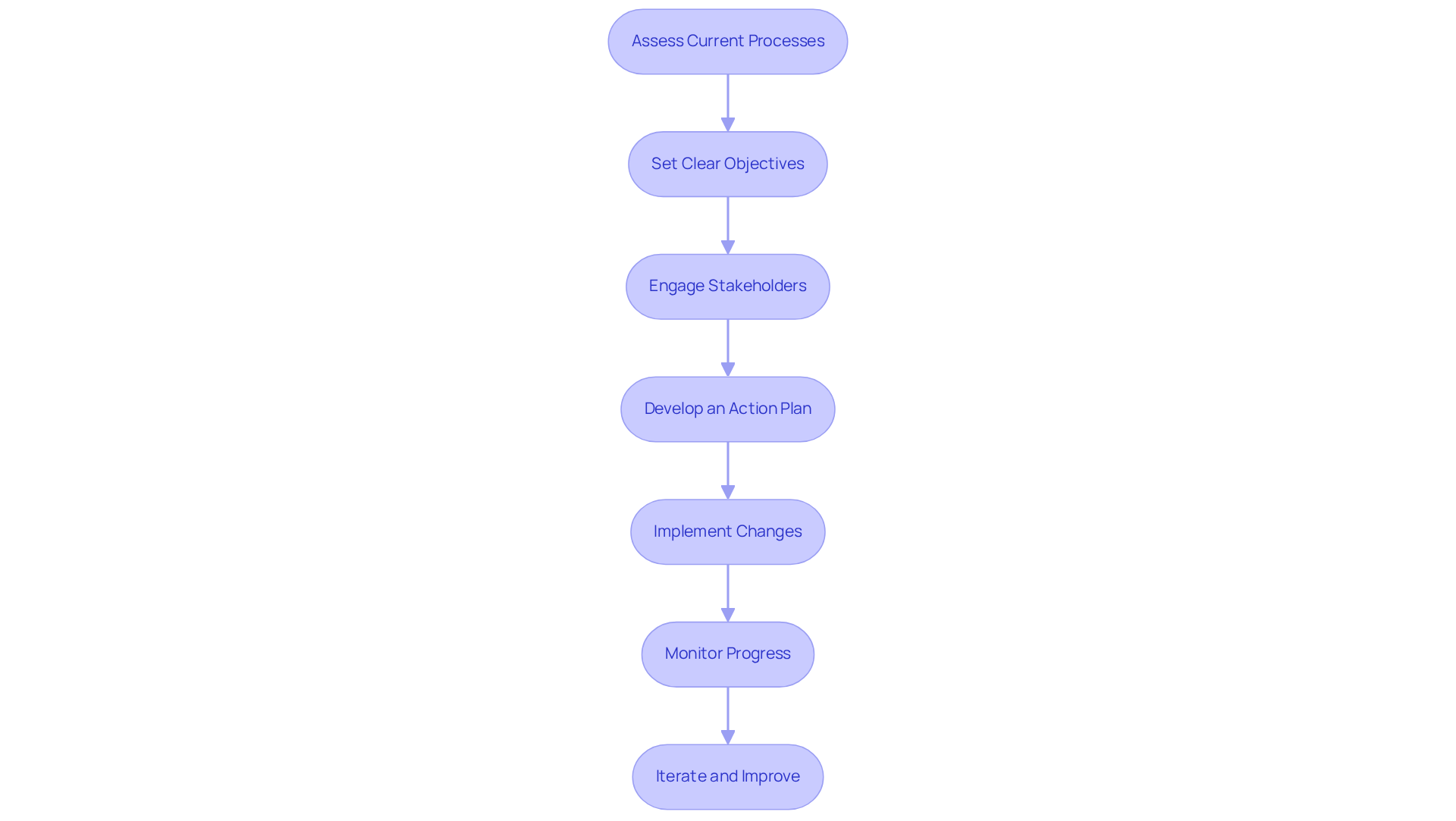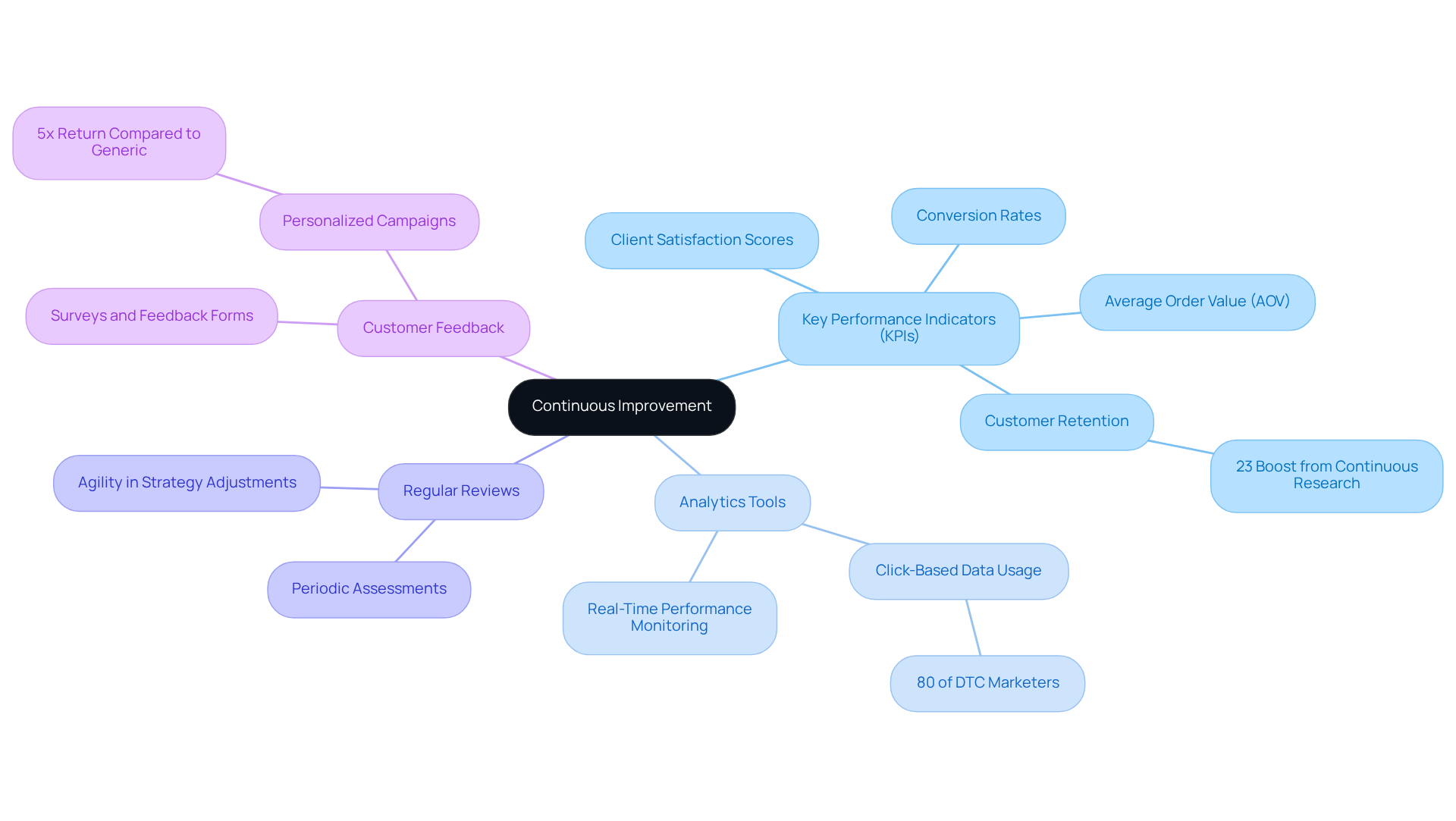
Overview
This article delineates four crucial steps for optimizing processes that drive the success of direct-to-consumer (DTC) brands. The focus is on:
- Enhancing customer experience
- Boosting conversion rates
- Minimizing operational costs
- Maximizing data utilization
To achieve these goals, it is imperative to:
- Assess current workflows
- Establish clear objectives
- Engage stakeholders
- Formulate a comprehensive action plan
Collectively, these steps are designed to refine operations and elevate overall efficiency, as demonstrated by successful strategies employed by various DTC companies.
Introduction
Optimizing processes is essential for direct-to-consumer (DTC) brands aiming for success in a fiercely competitive market. By refining operations, companies can significantly enhance efficiency, reduce costs, and elevate customer satisfaction, ultimately aligning their activities with growth objectives. Yet, with escalating client acquisition costs and intricate logistics, how can DTC brands effectively streamline their processes to not merely survive but truly thrive?
This article explores a structured approach to process optimization, presenting actionable steps and insights that can transform operational challenges into opportunities for increased profitability and customer loyalty.
Define Process Optimization for DTC Brands
Improving operations for DTC companies represents a systematic approach to refining business activities aimed at boosting efficiency, reducing costs, and enhancing client satisfaction. This process involves a thorough analysis of existing workflows, the identification of bottlenecks, and the implementation of changes designed to streamline operations.
For instance, a DTC company might enhance its order fulfillment by integrating automated inventory management systems, significantly reducing delivery times and elevating the client experience. DTC companies face challenges such as high client acquisition costs and complex logistics, making the enhancement of efficiency even more critical.
Recent trends indicate that 14% of online consumers purchased items directly from company websites in 2023, underscoring the urgent need for companies to refine their systems to improve satisfaction and drive sales. By focusing on operational improvements to optimize processes, companies can ensure that every aspect of their operations aligns with their growth objectives, ultimately leading to increased profitability and customer loyalty.
As Jason Reiser, CEO of Market Performance Group, emphasizes, "To enhance your connected commerce strategy, companies need full-funnel omnichannel approaches, integrating Amazon, retail, and wholesale to meet customers where they are and drive sales.

Identify Key Goals of Process Optimization
The primary objectives of process optimization for direct-to-consumer (DTC) brands encompass several critical areas:
-
Improving Customer Experience: Simplifying procedures is essential for ensuring a seamless shopping journey, from initial browsing to final checkout. This approach can significantly reduce cart abandonment, which affects nearly 70% of online shoppers. For instance, a $30M apparel brand that redesigned its homepage to emphasize social proof and reviews experienced a remarkable 93% increase in homepage scroll depth, indicating enhanced customer engagement.
-
Increasing Conversion Rates: Implementing strategies that minimize obstacles in the purchasing journey encourages more visitors to complete their transactions. Brands that refine their checkout processes—such as by introducing free shipping thresholds and gamified progress bars—can achieve conversion rate increases of up to 29%. A notable case involved a cleaning product company that improved its conversion rate by 73% through these methods.
-
Reducing Operational Costs: Identifying and addressing inefficiencies in supply chain management and fulfillment can effectively lower operational costs without compromising quality. This is particularly crucial as rising client acquisition expenses threaten profitability. Parah Group's strategy has assisted companies like STRNG Seeds in reducing advertising expenses by creating tailored landing pages, which also increased their average order value (AOV) by 90%.
-
Enhancing Data Utilization: Effectively leveraging customer information empowers companies to personalize marketing efforts and optimize inventory management, leading to improved customer satisfaction and loyalty. By establishing these objectives, DTC brands can formulate a focused plan for their improvement initiatives, ultimately fostering growth and profitability. Incorporating insights from industry leaders and examples from successful DTC companies, such as those highlighted by Parah Group, showcases the effectiveness of these strategies.

Implement a Step-by-Step Process Optimization Framework
To implement a process optimization framework successfully, DTC brands must follow these essential steps:
-
Assess Current Processes: Initiate a thorough analysis of existing workflows to identify inefficiencies and areas for improvement. Utilizing tools such as workflow mapping and stakeholder feedback enhances this evaluation.
-
Set Clear Objectives: Define specific, measurable goals that align with the overarching business strategy. Applying the SMART framework ensures that objectives are well-articulated and achievable, with a focus on enhancing accuracy and customer satisfaction.
-
Engage Stakeholders: Involve team members from various departments to gather diverse insights and promote collaboration. Engaging stakeholders not only strengthens the improvement initiative but also cultivates organizational support, which is crucial for effective implementation.
-
Develop an Action Plan: Formulate a comprehensive plan detailing the necessary steps to achieve the defined objectives, including timelines and responsibilities. This action plan should be transparent and accessible to all team members to facilitate seamless execution.
-
Implement Changes: Execute the action plan, ensuring that all team members are well-informed and adequately trained on the new processes. Effective communication during this phase is vital to minimize resistance and enhance adoption.
-
Monitor Progress: Regularly review performance metrics to assess the effectiveness of the changes. This ongoing evaluation allows us to optimize process by making timely adjustments and ensuring that improvement efforts align with business objectives.
-
Iterate and Improve: Continuously seek feedback and explore additional optimization opportunities. Fostering a culture of ongoing improvement is essential to optimize processes for sustaining efficiency and adapting to shifting market conditions.
By adhering to these steps, DTC companies can significantly enhance their operational efficiency, reduce costs, and improve overall performance, positioning themselves for long-term success.

Measure and Analyze Results for Continuous Improvement
To drive continuous improvement, DTC companies must implement essential practices for measuring and analyzing results.
-
Establish Key Performance Indicators (KPIs): It is crucial to identify KPIs that align with enhancement goals, such as conversion rates, average order value (AOV), and client satisfaction scores. Research indicates that companies consistently tracking their audience experience a remarkable 23% boost in customer retention.
-
Utilize Analytics Tools: Leverage analytics platforms to monitor performance metrics in real-time, enabling swift adjustments based on data insights. Notably, over 80% of DTC marketers rely on click-based data as their primary measurement source, underscoring the necessity for robust analytics.
-
Conduct Regular Reviews: Schedule periodic assessments of optimization efforts to evaluate progress against established KPIs. This practice ensures that brands remain agile and responsive to market changes.
-
Gather Customer Feedback: Implement surveys and feedback forms to gain insights into customer experiences, aiding in the identification of areas for further enhancement. Personalized campaigns informed by research can yield up to five times the return compared to generic approaches.
Adjust strategies accordingly to optimize process and refine strategies based on analysis to enhance effectiveness and address emerging challenges. By committing to this cycle of measurement and analysis, DTC brands can cultivate a culture of continuous improvement that drives long-term success.

Conclusion
Optimizing processes is crucial for the success of direct-to-consumer (DTC) brands, as it directly influences efficiency, cost reduction, and customer satisfaction. By refining operations and addressing inefficiencies, DTC companies can align their workflows with growth objectives, resulting in enhanced profitability and stronger customer loyalty.
This article outlines several key strategies for effective process optimization. These include:
- Improving customer experience through streamlined procedures
- Increasing conversion rates by minimizing obstacles in the purchasing journey
- Reducing operational costs through efficient supply chain management
- Leveraging data for personalized marketing efforts
Implementing a structured framework that involves assessing current processes, setting clear objectives, engaging stakeholders, and continuously measuring results is critical for achieving these goals.
Ultimately, the significance of process optimization in the DTC landscape cannot be overstated. As consumer expectations evolve and competition intensifies, brands must commit to ongoing improvement and adaptability. By embracing a culture of continuous enhancement and utilizing data-driven insights, DTC companies can not only survive but thrive in a dynamic market, ensuring they meet customer needs effectively and sustainably.
Frequently Asked Questions
What is process optimization for DTC brands?
Process optimization for DTC (Direct-to-Consumer) brands involves systematically refining business activities to boost efficiency, reduce costs, and enhance client satisfaction through thorough analysis and improvements of existing workflows.
How can DTC companies improve their operations?
DTC companies can improve operations by identifying bottlenecks in their workflows and implementing changes, such as integrating automated inventory management systems to enhance order fulfillment, reduce delivery times, and elevate the client experience.
What challenges do DTC brands face that make process optimization important?
DTC brands face challenges such as high client acquisition costs and complex logistics, making the enhancement of efficiency critical for their success.
What recent trend highlights the need for DTC brands to refine their systems?
In 2023, 14% of online consumers purchased items directly from company websites, underscoring the urgent need for DTC brands to optimize their systems to improve customer satisfaction and drive sales.
How does process optimization impact profitability and customer loyalty for DTC brands?
By focusing on operational improvements to optimize processes, DTC brands can align every aspect of their operations with growth objectives, ultimately leading to increased profitability and enhanced customer loyalty.
What does Jason Reiser suggest for enhancing connected commerce strategies?
Jason Reiser emphasizes the need for full-funnel omnichannel approaches, integrating platforms like Amazon, retail, and wholesale to meet customers where they are and drive sales.
FAQs











